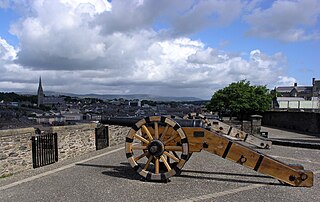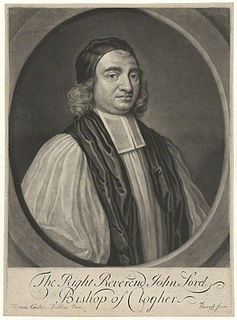| |||||
| Centuries: | |||||
|---|---|---|---|---|---|
| Decades: | |||||
| See also: | Other events of 1609 List of years in Ireland | ||||
Events from the year 1609 in Ireland.
| |||||
| Centuries: | |||||
|---|---|---|---|---|---|
| Decades: | |||||
| See also: | Other events of 1609 List of years in Ireland | ||||
Events from the year 1609 in Ireland.

The Honourable The Irish Society is a consortium of livery companies of the City of London established during the Plantation of Ulster to colonise County Londonderry. It was created in 1609 within the City of London Corporation, and incorporated in 1613 by royal charter of James I. In its first decades the society rebuilt the city of Derry and town of Coleraine, and for centuries it owned property and fishing rights near both towns. Some of the society's profits were used to develop the economy and infrastructure of the area, while some was returned to the London investors, and some used for charitable work.

The Plantation of Ulster was the organised colonisation (plantation) of Ulster – a province of Ireland – by people from Great Britain during the reign of King James I. Most of the settlers came from southern Scotland and northern England; their culture differed from that of the native Irish. Small privately funded plantations by wealthy landowners began in 1606, while the official plantation began in 1609. Most of the colonised land had been confiscated from the native Gaelic chiefs, several of whom had fled Ireland for mainland Europe in 1607 following the Nine Years' War against English rule. The official plantation comprised an estimated half a million acres (2,000 km2) of arable land in counties Armagh, Cavan, Fermanagh, Tyrone, Donegal, and Londonderry. Land in counties Antrim, Down, and Monaghan was privately colonised with the king's support.

Down Cathedral, the Cathedral Church of the Holy and Undivided Trinity, is a Church of Ireland cathedral located in the town of Downpatrick in Northern Ireland. It stands on Cathedral Hill overlooking the town. It is one of two cathedrals in the Diocese of Down and Dromore. The cathedral is the centre point of Downpatrick a relatively new name for the settlement having only come into usage in the seventeenth century.

The Irish Rebellion of 1641 was an uprising by Irish Catholics in the Kingdom of Ireland, who wanted an end to anti-Catholic discrimination, greater Irish self-governance, and to partially or fully reverse the plantations of Ireland. They also wanted to prevent a possible invasion or takeover by anti-Catholic English Parliamentarians and Scottish Covenanters, who were defying the king, Charles I. It began as an attempted coup d'état by Catholic gentry and military officers, who tried to seize control of the English administration in Ireland. However, it developed into a widespread rebellion and ethnic conflict with English and Scottish Protestant settlers, leading to Scottish military intervention. The rebels eventually founded the Irish Catholic Confederacy.

Dromore is a small market town and civil parish in County Down, Northern Ireland. It lies within the local government district of Armagh City, Banbridge and Craigavon. It is 19 miles (31 km) southwest of Belfast, on the A1 Belfast–Dublin road. The 2011 Census recorded a population of 6,003.

The earliest references to the history of Derry date to the 6th century when a monastery was founded there; however, archaeological sites and objects predating this have been found. The name Derry comes from the Old Irish word Daire meaning 'oak grove' or 'oak wood'.

Plantations in 16th- and 17th-century Kingdom of Ireland involved the confiscation of Irish-owned land by the English Crown and the colonisation of this land with settlers from Great Britain. The Crown saw the plantations as a means of controlling, anglicising and 'civilising' parts of Ireland. The main plantations took place from the 1550s to the 1620s, the biggest of which was the plantation of Ulster. The plantations led to the founding of many towns, demographic and economic changes, changes in land ownership and the landscape, and also to ethnic and sectarian conflict. They took place before and during the earliest English colonisation of the Americas, and a group known as the West Country Men were involved in both Irish and American colonization.

The Diocese of Connor is in the Province of Armagh of the Church of Ireland.
The Bishop of Connor is an episcopal title which takes its name after the village of Connor in County Antrim, Northern Ireland. The title is currently used by the Church of Ireland, but in the Roman Catholic Church it has been united with another bishopric.
Events from the year 1689 in Ireland.
Events from the year 1736 in Ireland.

St Johnston, officially Saint Johnstown, is a village, townland, and an electoral division in County Donegal, Ireland. It is in the Laggan district of East Donegal on the left bank of the River Foyle. It is in the civil parish of Taughboyne and barony of Raphoe North, on the R236 (Lifford–Newtowncunningham) road where it overlaps the R265 (Carrigans–Raphoe) road. The village is about 12 kilometres (7.5 mi) south of Derry.

The Diocese of Down and Dromore is a diocese of the Church of Ireland in the south east of Northern Ireland. It is in the ecclesiastical province of Armagh. The geographical remit of the diocese covers half of the City of Belfast to the east of the River Lagan and the part of County Armagh east of the River Bann and all of County Down.
The Bishop of Dromore is an episcopal title which takes its name after the original monastery of Dromore in County Down, Northern Ireland. In the Roman Catholic Church the title still continues as a separate bishopric, but in the Church of Ireland it has been united with other bishoprics.

Protestantism is a Christian minority on the island of Ireland. In the 2011 census of Northern Ireland, 48% (883,768) described themselves as Protestant, which was a decline of approximately 5% from the 2001 census. In the 2011 census of the Republic of Ireland, 4.27% of the population described themselves as Protestant. In the Republic, Protestantism was the second largest religious grouping until the 2002 census in which they were exceeded by those who chose "No Religion". Some forms of Protestantism existed in Ireland in the early 16th century before the English Reformation, but demographically speaking these were very insignificant and the real influx of Protestantism began only with the spread of the English Reformation to Ireland. The Church of Ireland was established by King Henry VIII of England, who had himself proclaimed as King of Ireland.
Nicholas Greaves, D.D. (1605?–1673) was an English churchman who was Dean of Dromore cathedral, County Down.
Events from the year 1613 in Ireland.
Events from the year 1611 in Ireland.
Ulster Protestants are an ethnoreligious group in the Irish province of Ulster, where they make up about 43% of the population. Most Ulster Protestants are descendants of settlers who arrived from Britain in the early 17th century Ulster Plantation. This was the settlement of the Gaelic, Catholic province of Ulster by Scots and English speaking Protestants, mostly from the Scottish Lowlands and Northern England. Many more Scottish Protestant migrants arrived in Ulster in the late 17th century. Those who came from Scotland were mostly Presbyterians, while those from England were mostly Anglicans. There is also a small Methodist community and the Methodist Church in Ireland dates to John Wesley's visit to Ulster in 1752. Although most Ulster Protestants descend from Lowland Scottish people and English, some also descend from Irish, Welsh and Huguenots.

John Sterne (1660–1745) was an Irish churchman, bishop of Dromore from 1713 and then bishop of Clogher from 1717.